
Peat is an accumulation of partially decayed vegetation or organic matter. It is unique to natural areas called peatlands, bogs, mires, moors, or muskegs. Sphagnum moss, also called peat moss, is one of the most common components in peat, although many other plants can contribute. The biological features of sphagnum mosses act to create a habitat aiding peat formation, a phenomenon termed 'habitat manipulation'. Soils consisting primarily of peat are known as histosols. Peat forms in wetland conditions, where flooding or stagnant water obstructs the flow of oxygen from the atmosphere, slowing the rate of decomposition. Peat properties such as organic matter content and saturated hydraulic conductivity can exhibit high spatial heterogeneity.
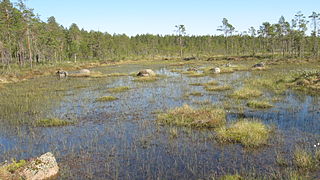
A bog or bogland is a wetland that accumulates peat as a deposit of dead plant materials – often mosses, typically sphagnum moss. It is one of the four main types of wetlands. Other names for bogs include mire, mosses, quagmire, and muskeg; alkaline mires are called fens. A bayhead is another type of bog found in the forest of the Gulf Coast states in the United States. They are often covered in heath or heather shrubs rooted in the sphagnum moss and peat. The gradual accumulation of decayed plant material in a bog functions as a carbon sink.

The Magellanic subpolar forests are a terrestrial ecoregion of southernmost South America, covering parts of southern Chile and Argentina, and are part of the Neotropical realm. It is a temperate broadleaf and mixed forests ecoregion, and contains the world's southernmost forests.

Sphagnum is a genus of approximately 380 accepted species of mosses, commonly known as sphagnum moss, also bog moss and quacker moss. Accumulations of Sphagnum can store water, since both living and dead plants can hold large quantities of water inside their cells; plants may hold 16 to 26 times as much water as their dry weight, depending on the species. The empty cells help retain water in drier conditions.
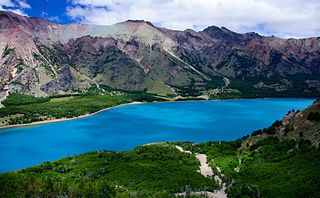
The Aysén del General Carlos Ibáñez del Campo Region, often shortened to Aysén Region or Aisén, is one of Chile's 16 first order administrative divisions. Although the third largest in area, the region is Chile's most sparsely populated region with a population of 102,317 as of 2017. The capital of the region is Coyhaique, the region's former namesake. The region's current namesake is the former President of Chile, General Carlos Ibáñez del Campo.

Burns Bog is an ombrotrophic peat bog located in Delta, British Columbia, Canada. It is the largest raised peat bog and the largest undeveloped urban land mass on the West Coast of the Americas. Burns Bog was originally 4,000–4,900 hectares before development. Currently, only 3,500 hectares remain of the bog.

Cors Caron is a raised bog in Ceredigion, Wales. Cors is the Welsh word for "bog". Cors Caron covers an area of approximately 349 hectares. Cors Caron represents the most intact surviving example of a raised bog landscape in the United Kingdom. About 44 different species groups inhabit the area including various land and aquatic plants, fish, insects, crustaceans, lichen, fungi, terrestrial mammals and birds.

Aulacomnium palustre, the bog groove-moss or ribbed bog moss, is a moss that is nearly cosmopolitan in distribution. It occurs in North America, Hispaniola, Venezuela, Eurasia, and New Zealand. In North America, it occurs across southern arctic, subboreal, and boreal regions from Alaska and British Columbia to Greenland and Quebec. Documentation of ribbed bog moss's distribution in the contiguous United States is probably incomplete. It is reported sporadically south to Washington, Wyoming, Georgia, and Virginia.

Sphagnum angustifolium, the fine bogmoss, is a species of peat moss with a Holarctic distribution.
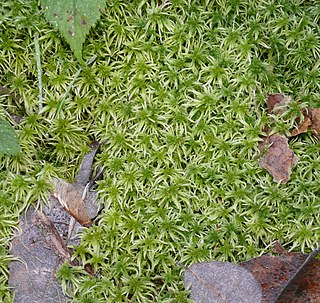
Sphagnum girgensohnii, also known as Girgensohn's bogmoss, Girgensohn's sphagnum or common green peat moss, is a species of peat moss with a Holarctic and Indo-Malesian distribution.
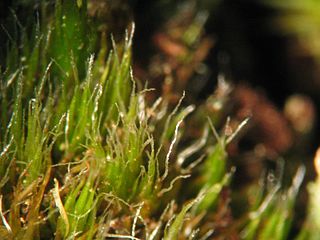
Campylopus introflexus, also known as the heath star moss, is a species of moss. The first description of the species was made by Johannes Hedwig as Dicranum introflexum in 1801.

Sphagnum palustre, the prairie sphagnum or blunt-leaved bogmoss, is a species of peat moss from the genus Sphagnum, in the family Sphagnaceae. Like other mosses of this type it can soak up water up to the 30-fold amount of its own dry weight thanks to its elastic spiral fibers. S. palustre is rather frequent and is spread almost all over the world. It mainly grows in wet forests and—compared to other specimens of this genus—rarely grows in moors.

Sphagnum capillifolium, the red bogmoss, northern peat moss, acute-leaved bog-moss, or small red peat moss, is a species of peat moss native to Canada, the northern United States, Greenland, and Europe. Small red peat moss can be distinguished by its sweeping, outward-curving branches that resemble tresses. Sphagnum moss can hold large amounts of water within its cells, up to 20 times its own weight. This capability is due to its dead, empty cells called hyaline cells that fill up with water. This allows the moss to survive in wet, boggy habitats around rivers and lakes.

Sphagnum fuscum, the rusty bogmoss or rusty peat moss, is a peat moss found commonly in Norway and Sweden, and can be found scattered across North America, the United Kingdom, and in southern to eastern Europe.

Sphagnum cuspidatum, the feathery bogmoss, toothed sphagnum, or toothed peat moss, is a peat moss found commonly in Great Britain, Norway, Sweden, the eastern coast of the United States, and in Colombia.
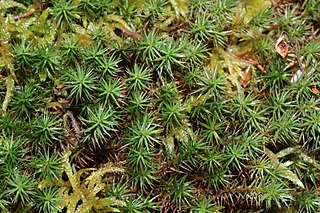
Polytrichum strictum, commonly known as bog haircap moss or strict haircap, is an evergreen and perennial species of moss native to Sphagnum bogs and other moist habitats in temperate climates. It has a circumboreal distribution, and is also found in South America and Antarctica.

The Magellanic moorland or Magellanic tundra is an ecoregion on the Patagonian archipelagos south of latitude 48° S. It is characterized by high rainfall with a vegetation of scrubs, bogs and patches of forest in more protected areas. Cushion plants, grass-like plants and bryophytes are common.

Sphagnum papillosum, the papillose peatmoss, is a species of peat moss distributed throughout the northern hemisphere. Although sometimes confused with Sphagnum imbricatum and Sphagnum palustre, it is distinguished by its yellow-green to brown short, blunt branches and papillose chlorophyllose cells.

Sphagnum contortum is a species of moss reported in North America and Europe. NatureServe marked its global conservation status as Secure.



















